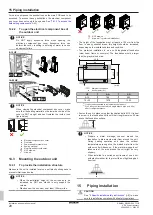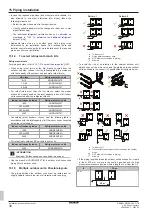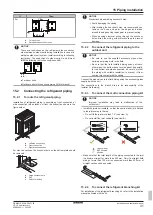
8 Troubleshooting
Installation and operation manual
17
REMA5+REYA8~20A7Y1B
VRV 5 heat recovery
4P684060-1 – 2022.02
WARNING
Stop operation and shut OFF the power if anything
unusual occurs (burning smells etc.).
Leaving the unit running under such circumstances may
cause breakage, electrical shock or fire. Contact your
dealer.
The system MUST be repaired by a qualified service person.
Malfunction
Measure
If a safety device such as a fuse, a
breaker or an earth leakage breaker
frequently actuates or the ON/OFF
switch does NOT properly work.
Turn OFF the main power
switch.
The operation switch does NOT work
well.
Turn OFF the power
supply.
If the user interface display indicates the
unit number, the operation lamp flashes
and the malfunction code appears.
Notify your installer and
report the malfunction
code.
If the system does NOT operate properly except for the above
mentioned cases and none of the above mentioned malfunctions is
evident, investigate the system in accordance with the following
procedures.
Malfunction
Measure
If a refrigerant leak
occurs (error code
/
)
▪ Actions will be taken by the system. Do
NOT turn OFF the power supply.
▪ Notify your installer and report the
malfunction code.
If the system does not
operate at all.
▪ Check if there is no power failure. Wait
until power is restored. If power failure
occurs during operation, the system
automatically restarts immediately after
power is restored.
▪ Check if no fuse has blown or breaker is
activated. Change the fuse or reset the
breaker if necessary.
If the system goes into
fan only operation, but
as soon as it goes into
heating or cooling
operation, the system
stops.
▪ Check if air inlet or outlet of outdoor or
indoor unit is not blocked by obstacles.
Remove any obstacles and make sure
the air can flow freely.
▪ Check if the user interface display shows
on the home screen. Refer to the
installation
and
operation
manual
delivered with the indoor unit.
The system operates
but cooling or heating
is insufficient.
▪ Check if air inlet or outlet of outdoor or
indoor unit is not blocked by obstacles.
Remove any obstacles and make sure
the air can flow freely.
▪ Check if the air filter is not clogged (refer
to "Maintenance" in the indoor unit
manual).
▪ Check the temperature setting.
▪ Check the fan speed setting on your user
interface.
▪ Check for open doors or windows. Close
doors and windows to prevent wind from
coming in.
▪ Check if there are too many occupants in
the room during cooling operation. Check
if the heat source of the room is
excessive.
▪ Check if direct sunlight enters the room.
Use curtains or blinds.
▪ Check if the air flow angle is proper.
If after checking all above items, it is impossible to fix the problem
yourself, contact your installer and state the symptoms, the complete
model name of the unit (with manufacturing number if possible) and
the installation date (possibly listed on the warranty card).
8.1
Error codes: Overview
In case a malfunction code appears on the indoor unit user interface
display, contact your installer and inform the malfunction code, the
unit type, and serial number (you can find this information on the
nameplate of the unit).
For your reference, a list with malfunction codes is provided. You
can, depending on the level of the malfunction code, reset the code
by pushing the ON/OFF button. If not, ask your installer for advice.
Main code
Contents
External protection device was activated
The R32 sensor in one of the indoor units has
detected a refrigerant leak
(a)
The R32 sensor in one of the BS unit has detected a
refrigerant leak.
/
Safety system error (leak detection)
(a)
EEPROM failure (indoor)
Drain system malfunction (indoor/BS unit)
Fan motor malfunction (indoor)
Swing flap motor malfunction (indoor)
Expansion valve malfunction (indoor)
Drain malfunction (indoor unit)
Filter dust chamber malfunction (indoor)
Capacity setting malfunction (indoor)
Transmission malfunction between main PCB and sub
PCB (indoor)
Heat exchanger thermistor malfunction (indoor; liquid)
Heat exchanger thermistor malfunction (indoor; gas)
Suction air thermistor malfunction (indoor)
Discharge air thermistor malfunction (indoor)
Movement detector or floor temperature sensor
malfunction (indoor)
R32 sensor malfunction in one of the indoor units
(a)
R32 sensor end of lifetime in one of the indoor units
(a)
User interface thermistor malfunction (indoor)
PCB malfunction (outdoor)
Current leakage detector was activated (outdoor)
High pressure switch was activated
Low pressure malfunction (outdoor)
Compressor lock detection (outdoor)
Fan motor malfunction (outdoor)
Electronic expansion valve malfunction (outdoor)
BS unit damper malfunction
Discharge temperature malfunction (outdoor)
Abnormal suction temperature (outdoor)
Refrigerant overcharge detection
High pressure switch malfunction
Low pressure switch malfunction
Fan motor malfunction (outdoor)
Ambient temperature sensor malfunction (outdoor)
Discharge temperature sensor malfunction (outdoor)
Suction temperature sensor malfunction (outdoor)
















































